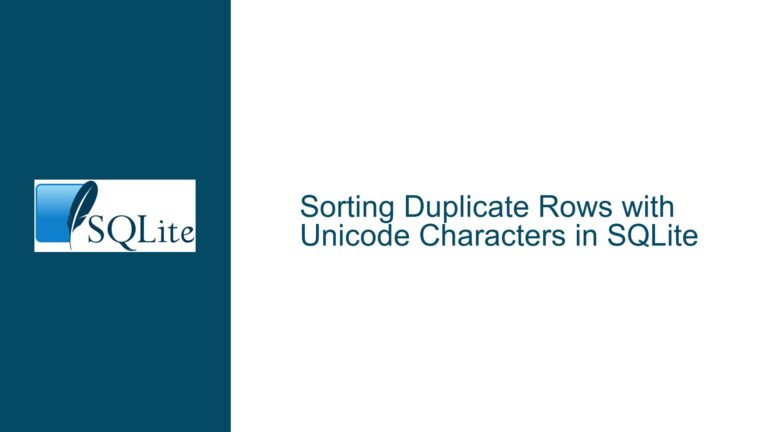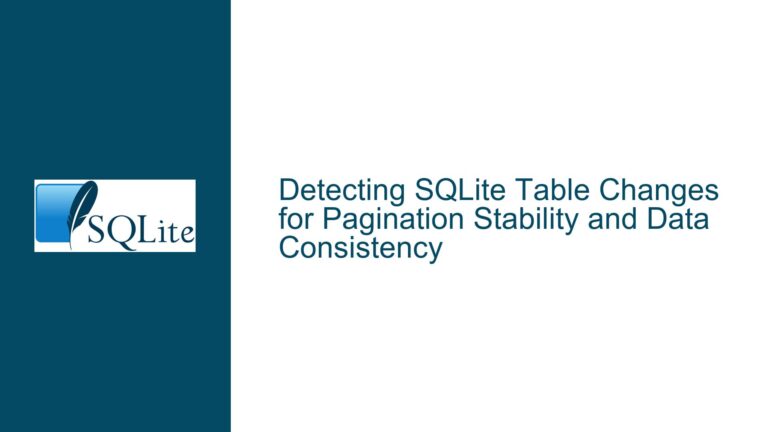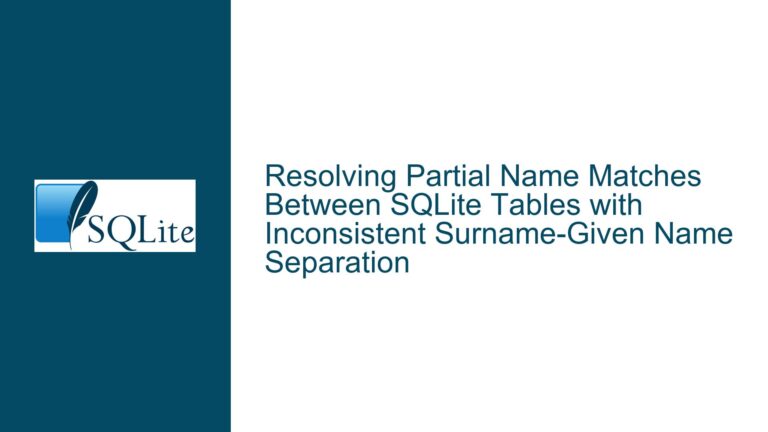Handling Unique Integer Primary Keys in SQLite for Legacy Data Migration
Unique Integer Primary Key Assignment Challenges in SQLite
When migrating legacy databases to SQLite, one common challenge is ensuring that existing unique integer key columns continue to function as expected. Specifically, the goal is to preserve the uniqueness of these keys while allowing new records to automatically generate unique values that are higher than the existing ones. This issue often arises when transitioning from a database system where unique keys were manually managed to SQLite, which has its own mechanisms for handling primary keys and row IDs.
In SQLite, the INTEGER PRIMARY KEY column is special because it aliases the rowid, a 64-bit signed integer that uniquely identifies each row in a table. By default, if you insert a row without specifying a value for this column, SQLite will automatically assign a value that is one greater than the largest rowid currently in the table. However, this behavior can be disrupted if the column is not properly defined or if the insertion process does not align with SQLite’s expectations.
The core issue here is ensuring that the legacy unique key column, now defined as an INTEGER PRIMARY KEY, continues to serve its purpose. This involves:
- Preserving existing unique key values from the legacy database.
- Ensuring new records automatically receive unique values that are higher than the existing ones.
- Avoiding scenarios where the column returns
NULLor0after an insert, which indicates a misconfiguration or misunderstanding of SQLite’s behavior.
Misconfigured INTEGER PRIMARY KEY and AUTOINCREMENT Misuse
The primary causes of the issue stem from misunderstandings or misconfigurations of SQLite’s INTEGER PRIMARY KEY and AUTOINCREMENT features. Below are the key factors contributing to the problem:
1. Improper Definition of INTEGER PRIMARY KEY
- For a column to alias the
rowidand automatically generate unique values, it must be explicitly defined asINTEGER PRIMARY KEY. If the column is defined asINT PRIMARY KEYorINT PK, SQLite will not treat it as an alias for therowid. This can lead to the column not being automatically populated with unique values, resulting inNULLor0upon insertion.
2. Unnecessary Use of AUTOINCREMENT
- The
AUTOINCREMENTkeyword is often misunderstood and misused. It is not required for most use cases and introduces additional overhead. WhenAUTOINCREMENTis used, SQLite maintains an internal table (sqlite_sequence) to track the highestrowidever assigned. This is only necessary if you must guarantee thatrowidvalues are never reused, even after rows are deleted. In most cases, omittingAUTOINCREMENTand relying on the default behavior ofINTEGER PRIMARY KEYis sufficient and more efficient.
3. Manual Insertion of Legacy Key Values
- When migrating legacy data, it is common to manually insert existing unique key values into the new SQLite table. If these values are inserted without proper handling, SQLite may not recognize the column as an alias for the
rowid, leading to unexpected behavior. For example, if you insert a row with a specific value for theINTEGER PRIMARY KEYcolumn, SQLite will respect that value but may not automatically generate new values for subsequent inserts unless the column is explicitly defined and used correctly.
4. Misuse of sqlite3_last_insert_rowid()
- The
sqlite3_last_insert_rowid()function is often misunderstood. It returns therowidof the most recently inserted row on a specific database connection. However, it is not a reliable way to determine the highestrowidin a table, especially in multi-threaded environments or when multiple tables are involved. Relying on this function for key generation can lead to incorrect assumptions and errors.
Properly Configuring INTEGER PRIMARY KEY and Migrating Legacy Data
To resolve the issue and ensure that the legacy unique key column functions correctly in SQLite, follow these steps:
1. Define the Column Correctly
- Ensure that the column is defined as
INTEGER PRIMARY KEY. For example:CREATE TABLE MyTable ( legacy_id INTEGER PRIMARY KEY, other_columns ... ); - This definition ensures that
legacy_idaliases therowidand will automatically generate unique values for new rows.
2. Migrate Legacy Data
- When migrating data from the legacy database, explicitly insert the existing unique key values into the
INTEGER PRIMARY KEYcolumn. For example:INSERT INTO MyTable (legacy_id, other_columns) SELECT old_unique_key, other_columns FROM LegacyTable; - This preserves the existing key values and ensures that SQLite recognizes the column as an alias for the
rowid.
3. Insert New Records
- For new records, omit the
legacy_idcolumn in theINSERTstatement to allow SQLite to automatically generate a unique value:INSERT INTO MyTable (other_columns) VALUES ('New Data'); - SQLite will assign a
legacy_idvalue that is one greater than the largest existing value in the table.
4. Avoid AUTOINCREMENT Unless Necessary
- Only use
AUTOINCREMENTif you must guarantee thatrowidvalues are never reused. In most cases, the default behavior ofINTEGER PRIMARY KEYis sufficient:CREATE TABLE MyTable ( legacy_id INTEGER PRIMARY KEY AUTOINCREMENT, other_columns ... ); - Note that
AUTOINCREMENTintroduces additional overhead and is rarely needed.
5. Verify the Configuration
- After migrating data and inserting new records, verify that the
legacy_idcolumn is functioning as expected:SELECT * FROM MyTable; - Ensure that new records have unique
legacy_idvalues that are higher than the existing ones.
6. Handle Edge Cases
- If you encounter issues where the
legacy_idcolumn returnsNULLor0, double-check the table definition and insertion process. Ensure that the column is defined asINTEGER PRIMARY KEYand that new records are inserted without specifying a value for this column.
7. Use Window Functions for Secondary Unique Keys
- If you need to maintain a secondary unique key column, consider using window functions to generate unique values during data migration:
INSERT INTO MyTable (legacy_id, secondary_unique_key, other_columns) SELECT old_unique_key, ROW_NUMBER() OVER (ORDER BY old_unique_key), other_columns FROM LegacyTable; - This approach ensures that the secondary unique key column is populated with unique values based on the existing data.
8. Update Foreign Key References
- If the
legacy_idcolumn is referenced by other tables, ensure that these references are updated to reflect the newINTEGER PRIMARY KEYcolumn. This maintains the integrity of the database relationships.
By following these steps, you can successfully migrate legacy data to SQLite while preserving the functionality of unique integer key columns. Properly configuring INTEGER PRIMARY KEY and understanding SQLite’s behavior are key to achieving a seamless transition.






